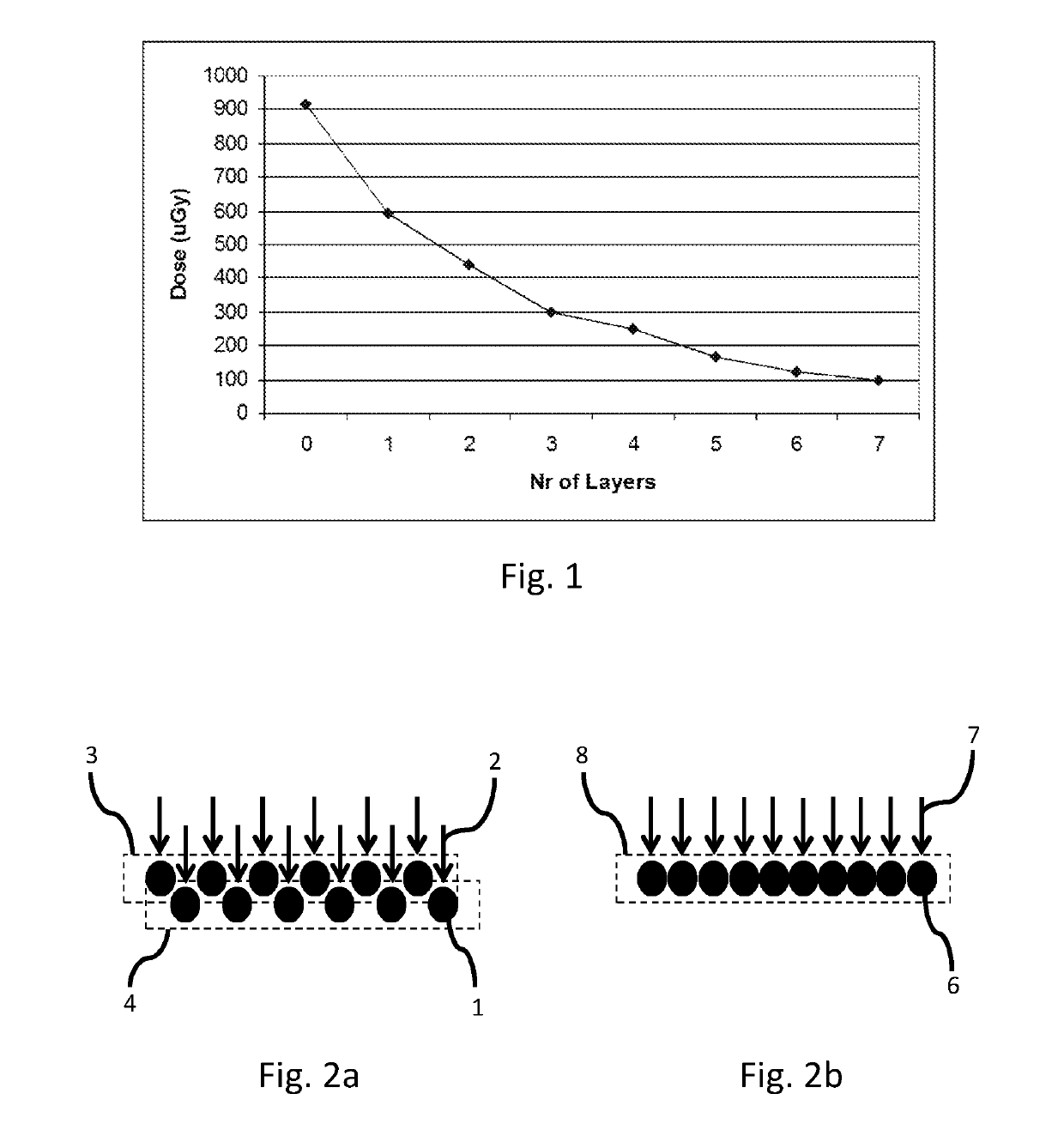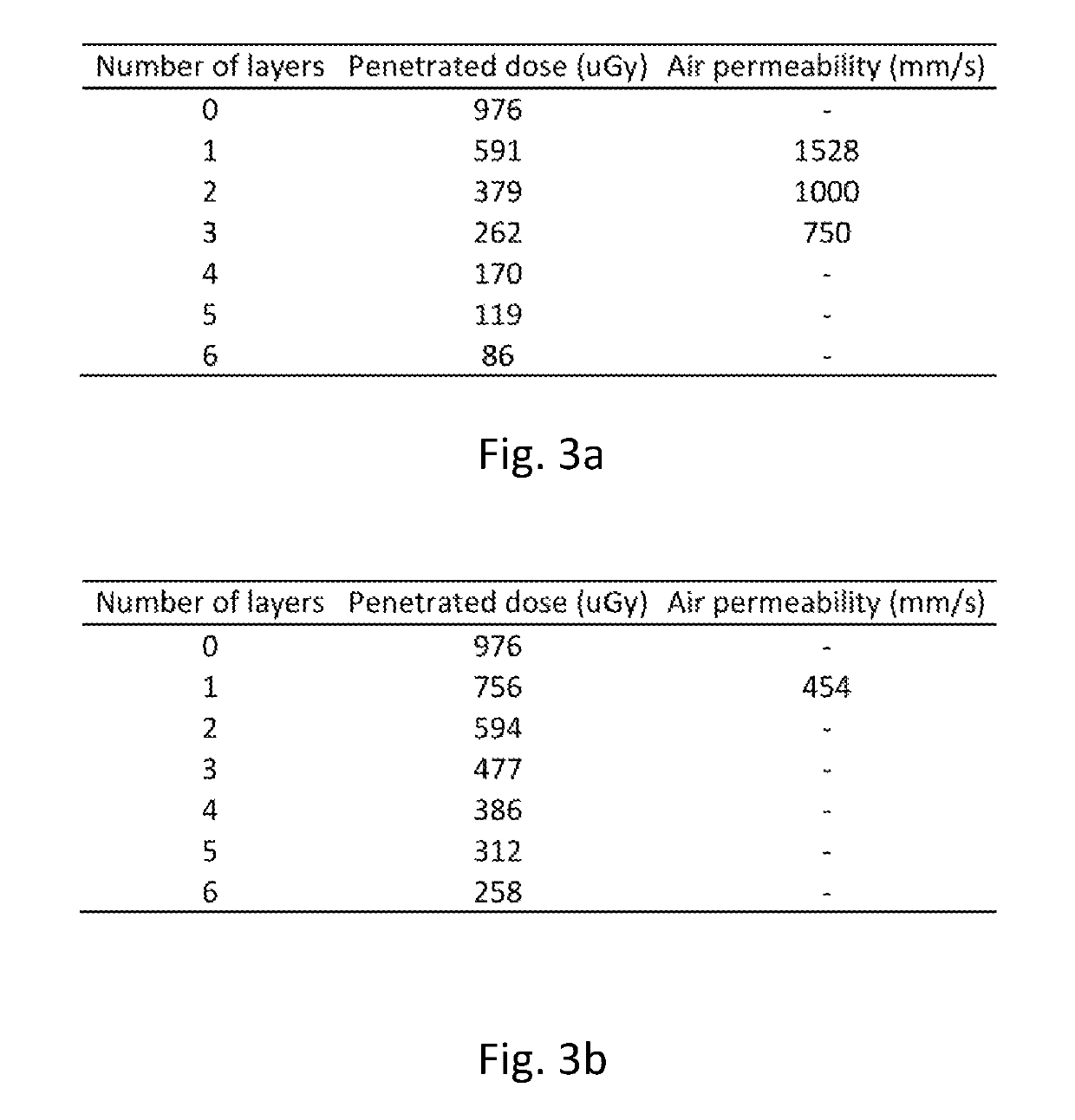Radiation protective material
a protective material and radiation technology, applied in the field of fibrous composite materials, can solve the problems of wearer discomfort, affecting affecting the effectiveness of radiation protection, so as to improve the comfort of wearer, improve the effect of protection, and improve the effect of comfor
- Summary
- Abstract
- Description
- Claims
- Application Information
AI Technical Summary
Benefits of technology
Problems solved by technology
Method used
Image
Examples
example 1
[0064]A radiation protective material according to embodiments of the invention was made by utilizing commercially available composite filaments including a radiopaque material (RONH 1030-785 / 2 from Roney Industri AB, Vellinge, Sweden, consisting of 61% of barium sulphate in a matrix of polyvinyl chloride and additives, having a diameter of 0.7 mm). The filaments were structured into a regular pattern by weaving in twill in order to form the radiation protective material and achieve an air permeable textile material having as high radiation protection as possible. The warp used in example 1 was monofilament polypropene (Nm30) with no radiopaque substance added. The twill was constructed with 20 wefts per cm textile material and the surface weight per layer was in this example 1.59 kg / m2.
[0065]In the table of FIG. 3a, it can be seen that the first layer of radiation protective material significantly decreases the penetrated radiation. Additional layers reduced at a lower degree but w...
example 2
[0067]A radiation protective material according to embodiments of the invention was made by utilizing a commercially available composite filaments including a radiopaque material (Barilen 60 from Saxa Syntape GmbH, Luebnitz, Germany which is a multifilament yarn of 60% barium sulphate in a polypropylene matrix, supported by filaments of polyester. There were 30 filaments at a fiber dimension of 2800-3200 m / kg where the single monofilament barium sulphate containing polypropene fiber had a diameter of about 0.06 mm). The filaments were structured into a regular pattern by weaving in twill in order to form the radiation protective material and achieve an air permeable textile material having as high radiation protection as possible. The warp used in example 2 was cotton (Nm 32 / 2) with no radiopaque substance added. The twill was constructed with 20 wefts per cm textile material and the surface weight per layer was in this example 0.92 kg / m2.
[0068]The table of FIG. 3b shows the radiati...
example 3
[0071]A radiation protective material from Kemmetech Ltd (Unit 4 Arnold Business Park, Branbridges Rd, East Peckham, Kent, TN12 5LG, UK) was purchased, with reference code FSLF0125 / 1200 / U / NT. The material is specified as a Lead free vinyl sheet. The sheet was shredded into fragments using a pair of scissors and then fed into an extruder at a temperature of approximately 170 degrees Celsius. The fiber was led through a water bath with very little tension and then winded onto a roll. The fiber diameter was measured to 0.76 mm. The fiber was then woven to a twill fabric using equipment from Dornier. The final fabric had 22 fibers of the radiation protective material per centimeter. The radiation absorption was measured according to the above example using the Philips Super8CP generator. In order to absorb 90% of the irradiation, it was needed 3.48 kg / m2 of the Lead free vinyl sheet from Kemmetech Ltd whereas it was needed 3.61 kg / m2 of the fabric processed as described above. The decre...
PUM
| Property | Measurement | Unit |
|---|---|---|
| diameter | aaaaa | aaaaa |
| thickness | aaaaa | aaaaa |
| diameter | aaaaa | aaaaa |
Abstract
Description
Claims
Application Information
 Login to View More
Login to View More - R&D
- Intellectual Property
- Life Sciences
- Materials
- Tech Scout
- Unparalleled Data Quality
- Higher Quality Content
- 60% Fewer Hallucinations
Browse by: Latest US Patents, China's latest patents, Technical Efficacy Thesaurus, Application Domain, Technology Topic, Popular Technical Reports.
© 2025 PatSnap. All rights reserved.Legal|Privacy policy|Modern Slavery Act Transparency Statement|Sitemap|About US| Contact US: help@patsnap.com


